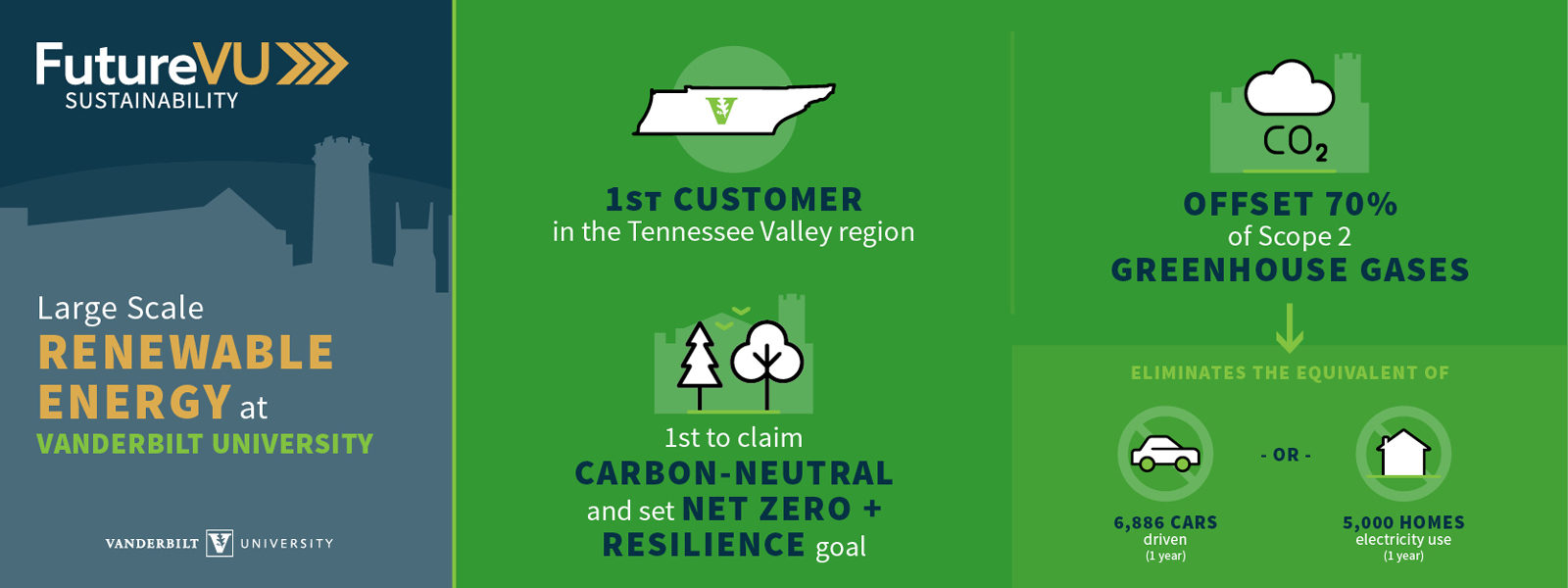Silicon Ranch Corporation to build Bedford County solar farm to open in 2022

Vanderbilt University has entered into a pioneering agreement with the Tennessee Valley Authority and Nashville Electric Service to procure off-site large-scale renewable energy to help mitigate the campus’ greenhouse gas emissions. The 20-year agreement will support Vanderbilt’s goal to power its campus entirely through renewable energy and become carbon neutral by the year 2050.
The renewable power will come from a solar farm to be built in Bedford County, Tennessee, by Nashville-based Silicon Ranch Corporation, the U.S. solar platform for Shell and one of the largest independent solar power producers in the country. The next phase of the project is an environmental review of the location. Upon successful completion of that review, Silicon Ranch will begin construction and targets fall 2022 for the facility to be operational.
Vanderbilt is the first customer to partner with a local power company on this type of agreement in the seven-state TVA region. It is also the first agreement finalized under the TVA’s new Green Invest program.

“This agreement is one of the largest single steps we can take to reduce our carbon emissions footprint and demonstrates that Vanderbilt is an incubator for solutions of regional, national and global issues,” Interim Chancellor and Provost Susan R. Wente said. “We want this partnership to serve as a model of collaboration that other organizations within our region and beyond can replicate to make long-term, lasting changes to protect our shared environment.
“We also hope this innovative partnership will provide a number of educational and research opportunities for our academic community,” she said.
The agreement is the result of two years of intensive effort by Vanderbilt to identify the best renewable energy strategy for the university on the basis of key criteria that include financial, social and environmental benefits and risk mitigation.

The new solar farm will supply up to 35 megawatts (MWAC) of renewable energy, an amount sufficient to offset approximately 70 percent of Vanderbilt’s annual indirect greenhouse gas emissions from purchased electricity—the equivalent of nearly 7,000 cars driven for one year or 5,000 homes utilizing electricity for one year, per the EPA’s Greenhouse Gas Equivalencies calculator.
“Off-site large-scale renewable energy is an integral part of FutureVU, Vanderbilt’s holistic campus planning initiative, and the university’s comprehensive long-term sustainability strategy,” said Eric Kopstain, vice chancellor for administration.
“We are proud to partner with TVA and NES to support renewable energy in the region and hope other institutions follow the example and invest in similar solutions,” he said.
Learn more about Vanderbilt’s sustainability goals. >>
While achieving carbon neutrality has become a sustainability standard at many American universities, Vanderbilt leaders have said they plan to go a step further and produce more renewable energy than consumed. Vanderbilt is the first premier institution in the Southeast to claim carbon neutrality and set a “Net Zero + Resilience” (net positive) goal for on-campus and purchased power.
Mike Vandenbergh, David Daniels Allen Distinguished Chair in Law and director of the Climate Change Research Network, said that Vanderbilt is demonstrating genuine leadership with this agreement.

“The large, total amount of renewable power is important, but the example for the region is invaluable,” Vandenbergh said. “Our research shows that in many areas of the country, colleges and universities, civic and cultural groups and businesses are playing a leading role in addressing climate change. The success of this effort sends a clear message that the move to renewable power does not need to wait for governments to act. It can be done in ways that are cost-effective and will make significant, near-term carbon emissions reductions.
“These kinds of private-sector actions can bypass the polarization and gridlock that have been so difficult to overcome regarding energy and climate policy,” he said.
Vanderbilt investigated ways it could invest in renewable energy through its BlueSky Energy Vision Study and Large-scale Renewable Energy Study, which explored potential options for off-campus large-scale renewable energy sources.
“The studies, conducted prior to forming this agreement, are an outstanding example of Vanderbilt faculty, staff and students coming together to solve real-world problems,” Kopstain said.
Vanderbilt Student Government President Frances Burton said the collaboration was pivotal for this process.
“Given the diverse stakeholders involved and the complexities of coming to this sort of agreement, I greatly appreciate that the student voice was not only heard, but actively solicited by university leaders,” Burton said. “Students have a huge stake in how renewable energy transitions are undertaken and achieved, so it was very meaningful to be involved in the process.”
Keegan Campanelli, president of the Vanderbilt organization Students Promoting Environmental Awareness and Responsibility, said reaching the carbon neutrality goal will not be an easy process, but this partnership marks a major success for the university less than a year from its initial announcement of the goal.
“Successes like these are critical for energizing a long-term movement,” Campanelli said. “The agreement demonstrates to the Vanderbilt community and beyond that the university is seriously committed to achieving—if not exceeding—its carbon neutrality goal, and it gives the entire community a benchmark by which to judge and inspire future successes for reducing carbon emissions.”